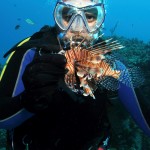Principal Investigator: Dr Dayne Buddo
The invasion of the Indo Pacific lionfish has presented a serious threat to local fisheries. Introduced through the aquarium trade, the lionfish has crossed natural barriers and has now invaded the Caribbean Region. The lack of natural predators and its high egg production has facilitated the growth of thriving populations throughout the Caribbean, Gulf of Mexico and off America’s Atlantic coast that can now be found in all types of marine environments. Research has shown the lionfish to consume over 27 different fish and shellfish species, presenting a serious threat to Jamaica’s already dwindling fisheries resources.
Over the past 4 years, The UWI has led a project to control the lionfish using adaptive research and management strategies. This has seen much success, with some sites currently showing a 75% decrease in lionfish densities when compared with 2009. A large part of this success is the multi-entity approach of public and private sector groups across the island in removal of the lionfish from these waters.
Based on the most recent survey conducted in Portland, there is need for more focussed attention on the San San area, especially the reef surrounding Alligator Head. This area is a vibrant fishing area with several important commercial species present, which support the coastal communities in Portland. A long-term monitoring program, a coordinated sustained removal program and a public awareness program are needed to control this species within this area. A comprehensive training program is required initially to build capacity in the area to fuel these programs.

